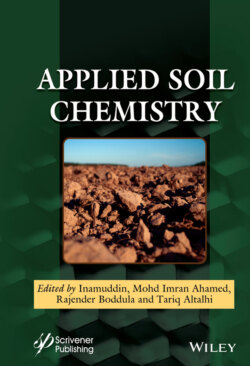Читать книгу Applied Soil Chemistry - Группа авторов - Страница 11
Оглавление
Preface
Soil chemistry refers to the chemical reactions in soils that affect the growth and nutrition of plants. Applied soil chemistry is an interdisciplinary field covering soil, water, plants and atmosphere, which impacts plant, animal and human health. Water and nutrients are provided in different types of soil that are home to microorganisms and many other creatures and plants. The properties of these soils affect the crop production of agricultural fields; therefore, this discipline provides support to the sustainable agricultural management of soils.
State-of-the-art information regarding applied soil sciences is explored in this book. In addition to the fundamentals of soil chemistry, model concepts, principles, chemical reactions, functions, chemical recycling, chemical weathering, acid-base chemistry, carbon sequestration, and nutrient availability of soils are highlighted. Also included among the topics are the chemistry of heavy metals in soil environments, ion-exchange processes on clay, along with relevant analytical tools and applications. This book will help the reader understand soil characteristics by targeting soil chemical reactions and interactions and their applications. Since the chapters were written by noted professionals in the field, it will be an excellent reference guide for students, faculty, researchers and professionals in the field of environmental science, earth science, soil chemistry, and agroecology. The subject matter covered in each chapter is summarized below.
Chapter 1 provides details on the significance of soils as a carbon store. Retaining and ideally boosting carbon in soils helps to inhibit its buildup in the atmosphere. It takes some time for soil carbon to become mineralized, whereas soil erosion and tillage continuously release some soil carbon into the atmosphere.
Chapter 2 provides background information on the chemical weathering of minerals. A discussion of the weathering sequence of minerals from the soil mainly sheds light on the factors which control the rate of chemical weathering, including temperature and time factors, biotic process, oxidation, reduction, comparative stability of various minerals, water, leaching, and acidity.
Chapter 3 discusses the effect that agricultural management systems have on soil health by evaluating reduced processing systems, organic fertilizers, and biological control of weeds, along with their effect on the bioeconomy, including agriculture, forestry, fishing, aquaculture, woodworking, biorefineries, and nanobiotechnology. The data provided is based on the evaluation of indicators of physical, chemical, biological, microbiological, and biochemical soil health. The benefits of soil resilience and better adaptation to extreme events are also included.
Chapter 4 discusses the advances in soil chemistry which are based on the analysis of the soil at an in-situ level and the presence of carbon speciation in soil. The analysis of the soil using sensors, the internet of things, machine learning, artificial intelligence, and drones with big data are also discussed.
Chapter 5 details the various components of soil, including solid, liquid and gaseous phases. Different soil characteristics like structure, soil color, texture, bulk density and particle size are discussed in detail. These are important parameters for understanding soil behavior. Sorption behavior of soil for removal of heavy metals is also discussed.
Chapter 6 relates to inclusive edaphology and environmental reactions. Parameters such as composition, textures, soil organic matter, salinity, acidity and chemical reaction of soil are discussed. The main focus is on different kinds of contaminants like pesticides, modern agriculture, synthetic chemicals and their effects on plant growth.
Chapter 7 describes fertilization and fertilizer types. The purpose of fertilization and its application methods are discussed. Fertilizers can be classified into two types depending on the source from which they are obtained: organic (natural) fertilizer and chemical fertilizer. The importance of the use of fertilizers in agricultural lands for sustainable agriculture is explained.
Chapter 8 discusses several approaches which are used to control the overabundance of heavy metals present in soil. The focus of this chapter are the techniques utilized in the past few years to estimate heavy metal content and its mitigation process.
Chapter 9 details the importance and benefits of modeling studies about the retention and mobilization of pollutants. Recently applied models and primary outcomes of modeling studies are also discussed. Additionally, several personal computer programs, which are used for running models, are exemplified in this study.
Chapter 10 provides details of the different laws of soil chemistry. The reaction of ions with the variable charged mineral surfaces, organic matters and clay minerals are discussed. The role of water movement through saturated and unsaturated media is also discussed, with a major focus on gravitational and capillary forces.
Chapter 11 discusses various aspects of assessing the quality of soil using mechanical and physicochemical parameters. Mechanical parameters, which play an essential role in plant growth, are also discussed. There is also a discussion of ion-exchange properties, which is the primary focus of the studies on physicochemical parameters.
Chapter 12 explains the necessary soil functions that could lead to an increase in agricultural production. Essential soil biological processes and their relationship with soil pH are also discussed along with microbial ecophysiological indicators and activities of soil enzymes.
Chapter 13 provides detailed information on the application of pesticides in agriculture. It also elaborates on the numerous types of pesticides, including neonicotinoids, pyrethroids, organochlorines, organophosphates, triazines, carbamates, and pyrethroids. The merits and demerits that are associated with chemical pesticides are also highlighted. This chapter also includes the modes of action and the detrimental effects of these pesticides.
Inamuddin, Mohd Imran Ahamed, Rajender Boddula and Tariq Altalhi February 15, 2021
